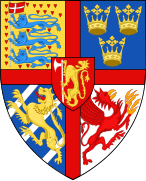
| Part of a series on |
| Heraldic achievement |
|---|
| External devices in addition to the central coat of arms |
Escutcheon
Field
Supporter
Crest
Torse
Mantling
Helmet
Crown
Compartment
Charge
Motto (or slogan)
Coat of arms

|
|
|
In heraldry, an inescutcheon is a smaller escutcheon that is placed within or superimposed over the main shield of a coat of arms, similar to a charge. This may be used in the following cases:
- as a simple mobile charge, for example as borne by the French family of Abbeville, illustrated below; these may also bear other charges upon them, as shown in the arms of the Swedish Collegium of Arms;
- in pretence (as a mark of a hereditary claim, usually by right of marriage), bearing assumed arms over one's own hereditary arms;
- in territorial claim, bearing a monarch's hereditary arms en surtout over the territorial arms of his domains.
-
 Escutcheons as mobile charges, as borne by the French family of Abbeville.
Escutcheons as mobile charges, as borne by the French family of Abbeville.
-
 Simple example of incorporating an heiress's arms as an escutcheon of pretense
Simple example of incorporating an heiress's arms as an escutcheon of pretense
-
 An escutcheon of pretence, as borne by the French family de Champagne-La Suze.
An escutcheon of pretence, as borne by the French family de Champagne-La Suze.
-
 Inherited arms borne en surtout over territorial arms. (Arms of Eric of Pomerania as monarch of the Kalmar Union, c. 15th century)
Inherited arms borne en surtout over territorial arms. (Arms of Eric of Pomerania as monarch of the Kalmar Union, c. 15th century)
As mobile charges

Inescutcheons may appear in personal and civic armory as simple mobile charges, for example the arms of the House of Mortimer, the Clan Hay or the noble French family of Abbeville. These mobile charges are of a particular tincture but do not necessarily bear further charges and may appear anywhere on the main escutcheon, their placement being specified in the blazon, if in doubt.
Inescutcheons may also be charged with other mobile charges, such as in the arms of the Swedish Collegium of Arms (Right) which bears the three crowns of Sweden, each upon its own escutcheon upon the field of the main shield. These inescutcheons serve as a basis for including other charges that do not serve as an augmentation or hereditary claim. In this case, the inescutcheons azure allow the three crowns of Sweden to be placed upon a field, thus not only remaining clearly visible but also conforming to the rule of tincture.
Of pretence

Inescutcheons may also be used to bear another's arms in "pretence".
In English heraldry the husband of a heraldic heiress, the sole daughter and heiress of an armigerous man (i.e. a lady without any brothers), rather than impaling his wife's paternal arms as is usual, must place her paternal arms in an escutcheon of pretence in the centre of his own shield as a claim ("pretence") to be the new head of his wife's family, now extinct in the male line. In the next generation the arms are quartered by the son.
Use by monarchs and states
A monarch's personal or hereditary arms may be borne on an inescutcheon en surtout over the territorial arms of his/her domains, as in the arms of Spain, the coats of arms of the Danish royal family members, the greater coat of arms of Sweden, or the arms of Oliver Cromwell as Lord Protector of the Commonwealth of England (1653–1659). The early Georgian kings of England bore an inescutcheon of the royal arms of Hanover on the arms of the Stuart monarchs of Great Britain, whose territories they now ruled.
-
 Arms of the Commonwealth of England, Scotland and Ireland, 1654–1655
Arms of the Commonwealth of England, Scotland and Ireland, 1654–1655
-
 Arms of the Commonwealth during the Protectorate of Oliver Cromwell, 1655–1659: Cromwell's personal arms (Sable, a lion rampant argent) appear as an inescutcheon.
Arms of the Commonwealth during the Protectorate of Oliver Cromwell, 1655–1659: Cromwell's personal arms (Sable, a lion rampant argent) appear as an inescutcheon.
Notes
- The origin of the inescutcheon of pretense lies in the armorial representation of territorial property. A man coming into lordship by right of his wife would naturally wish to bear the arms associated with that territory, and so would place them inescutcheon over his own; "and arms exclusively of a territorial character have certainly very frequently been placed 'in pretence'." It is also worth noting that the arms thus borne in pretence represent arms of assumption, while those on the larger shield represent arms of descent.
- Especially in continental Europe, sovereigns have long held the custom of bearing their hereditary arms in an inescutcheon en surtout over the territorial arms of their dominions. This custom, coupled with the frequency of European sovereigns ruling over several armigerous territories, may have given rise to the common European form of "quarterly with a heart".
References
- Fox-Davies 1909, p. 539.
- Fox-Davies 1909, p. 541.
Works cited
- Fox-Davies, Arthur Charles (1909). A Complete Guide to Heraldry: Illustrated by Nine Plates and Nearly 800 Other Designs. London: T.C. & E.C. Jack. ISBN 0-517-26643-1. LCCN 09023803.
| Heraldry | |||||||||||||||
|---|---|---|---|---|---|---|---|---|---|---|---|---|---|---|---|
| Types | |||||||||||||||
| Topics | |||||||||||||||
| Achievement | |||||||||||||||
| Charges | |||||||||||||||
| Tinctures |
| ||||||||||||||
| Applications | |||||||||||||||
| Related | |||||||||||||||
| |||||||||||||||